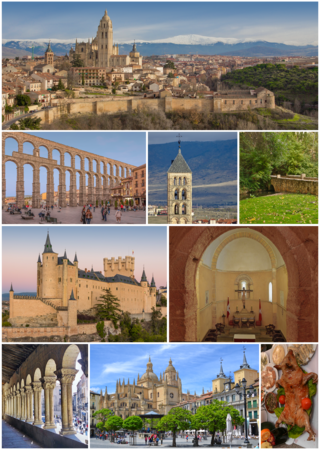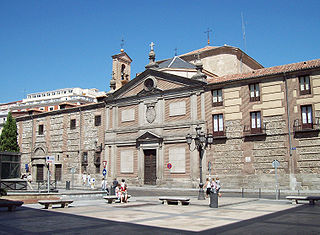
Segovia is a city in the autonomous community of Castile and León, Spain. It is the capital and most populated municipality of the Province of Segovia.

San Lorenzo de El Escorial, also known as El Escorial de Arriba, is a town and municipality in the Community of Madrid, Spain, located to the northwest of the region in the southeastern side of the Sierra de Guadarrama, at the foot of Mount Abantos and Las Machotas, 47 kilometres (29 mi) from Madrid. It is head of the eponymous judicial party. The settlement is popularly called El Escorial de Arriba, to differentiate it from the neighbouring village of El Escorial, also known as El Escorial de Abajo.

The Royal Palace of Madrid is the official residence of the Spanish royal family at the city of Madrid, although now used only for state ceremonies. The palace has 135,000 m2 (1,450,000 sq ft) of floor space and contains 3,418 rooms. It is the largest royal palace in Europe.

The Royal Sites are a set of palaces, monasteries, and convents built for and under the patronage of the Spanish monarchy. They are administered by Patrimonio Nacional (National Heritage), a Spanish state agency; most are open to the public, at least in part, except when they are needed for state or official events.

The Plaza de Oriente is a square in the historic center of Madrid, Spain. Rectangular in shape and monumental in character, it was designed in 1844 by Narciso Pascual y Colomer. The square was propagated by King Joseph I, who ordered the demolition of the medieval houses on the site.

The Convent of Las Descalzas Reales is a royal monastery situated in Madrid, Spain, administered by the Patrimonio Nacional.

Francesco Sabatini, also known as Francisco Sabatini, was an Italian architect who worked in Spain.

Patrimonio Nacional is a Spanish autonomous agency, under the jurisdiction of the Ministry of the Presidency, that administers the sites owned by the Spanish State and used by the Monarch and the Spanish Royal Family as residences and for State Ceremonies. The Patrimonio Nacional includes palaces, gardens, monasteries and convents, called the Royal sites. When not in official use, the Royal sites are open to the public. It also manages the official and holiday residences of the Prime Minister.

Ventura Rodríguez Tizón was a Spanish architect and artist. Born at Ciempozuelos, Rodríguez was the son of a bricklayer. In 1727, he collaborated with his father in the work at the Royal Palace of Aranjuez.
Antonio Fernández Arias was a Spanish painter of the Baroque period.

Saint Jerome the Royal is a Roman Catholic church from the early 16th-century in central Madrid (Spain).

The Real Monasterio de la Encarnación is a convent of the order of Recollet Augustines located in Madrid, Spain. The institution mainly interned women from noble families, and was founded by the Queen Margaret of Austria, wife of Philip III, and thus was well endowed with wealth. Although it belongs to an enclosed religious order, the building is open to the public under the administration of the Patrimonio Nacional.
Juan Gómez de Mora (1586–1648) was a Spanish architect, active in the 17th century. He was a main figure of Spanish early-Baroque architecture in the city of Madrid.

The Church of Our Lady of Montserrat is a Baroque-style, Roman Catholic church in central Madrid, Spain. Despite the imposing facade on Calle San Bernardo, the interior has relatively few bays because it was not possible to complete the building as originally projected.
Pascual is a Spanish given name and surname, cognate of Italian name Pasquale, Portuguese name Pascoal and French name Pascal. In Catalan-speaking area Pascual has the variant Pasqual.

The now defunct Convento de San Felipe el Real was a former Madrilenian convent of Calced Augustinian monks, located at the beginning of Calle Mayor in Madrid, next to the Puerta del Sol. Built between 16th and 17th centuries, was rise on a large pedestal, was part of it a famous talking shop of the city. One of its famous guests was Friar Luis de León. It was opposite the Palacio de Oñate.

Paradores de Turismo de España S.M.E.S.A., branded as Paradores, is a Spanish state-owned chain of luxury hotels that are usually located in historic buildings or in nature areas with a special appeal. Its very first parador was inaugurated on 9 October 1928 in Navarredonda de Gredos (Ávila). As of 2022, it operates 97 paradores in Spain and one in Portugal, with 5,988 rooms in total. Every parador has its own restaurant offering the regional gastronomy of its area.

The Sanctuary of St. Paschal Baylon, popularly known as El Sant, is located in Villarreal, in the province of Castellón (Spain). The complex consists of the "International Eucharistic Votive Temple", proclaimed a minor basilica by Pope John Paul II, the Royal Chapel with the tomb of Saint Paschal Baylon, the museum of the Pouet del Sant and the cloistered convent of the Poor Clare Mothers.


















